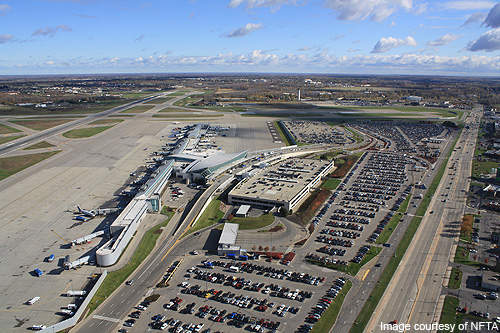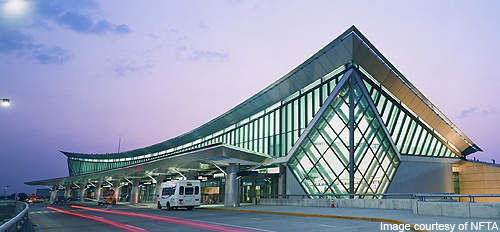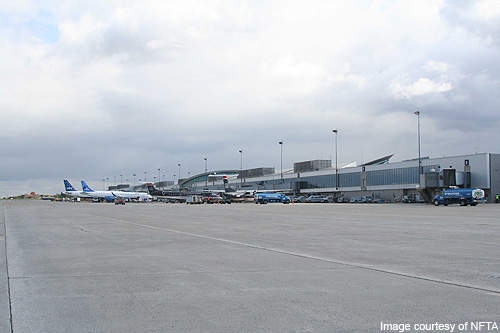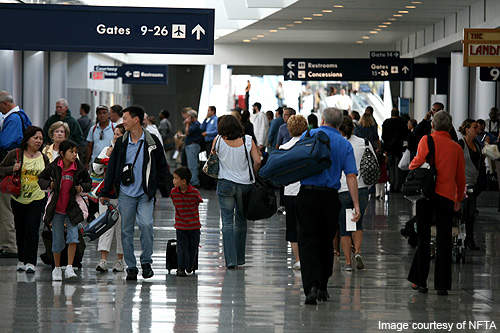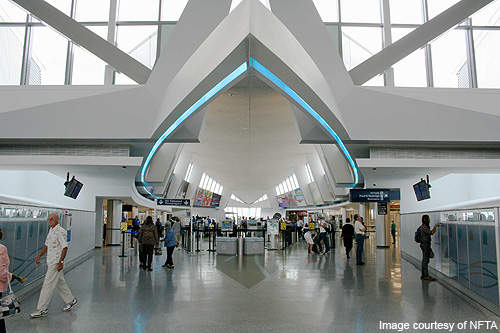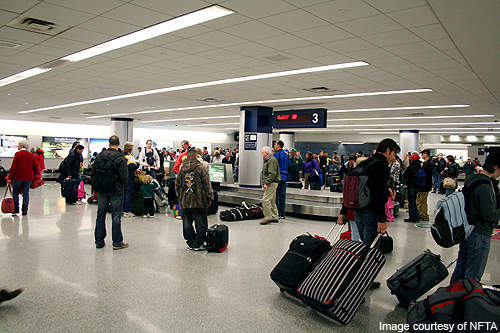The City of Buffalo constructed Buffalo Municipal Airport in 1926. The airport was acquired by Niagara Frontier Port Authority in 1956 and renamed the Greater Buffalo International Airport in 1959. The Niagara Frontier Transportation Authority (NFTA), which assimilated the airport in 1967, changed the airport’s name to Buffalo Niagara International Airport (BNIA) in September 1996.
The airport is located in Cheektowaga, New York, US. It handled 5.22 million passengers in 2010.
Buffalo Niagara International Airport design
BNIA’s only terminal was opened in November 1997. The terminal had cost $56m and contained 15 gates. The building was designed by a team led by New York based architects Kohn Pedersen Fox Associates.
The terminal is designed as a crystalline structure that appears like a big aircraft ready to take-off. The designers were influenced by Frank Lloyd Wright’s architecture and the importance of flight and aviation to Buffalo.
BNIA master plan
Since 1998, BNIA has witnessed a 71% increase in the number of passengers. A sustainable master plan was formulated to cope with the increase in traffic and prepare for the future. Designed by McFarland Johnson, the master plan execution involved three phases.
The airport currently has a glycol treatment plant with four cells. A part of the expansion master plan, the plant’s capacity is to be expanded by adding two new cells in 2012.
Financing and construction
In July 2004, the US Department of Transportation awarded an $11m Federal Aviation Administration (FAA) grant to Buffalo Niagara International Airport. The grant was used to improve runway safety and extend the taxiway.
DiDonata has been involved in a number of works at the BNIA since 1985. The works executed include apron, runway and taxiway extension and modification; fuel farm construction; remote fuel dispensing facility relocation-system rehabilitation; RON glycol containment storage facilities; airside facilities maintenance; landscaping; design of automated baggage system building and perimeter road extension.
A vertical flow aerated wetland treatment system with infiltration chambers for treatment of spent glycol from deicing operations was implemented at BNIA in 2008. The system was designed by Jacques Whitford NAWE and built by Kandey Company. The Quick4 chambers by Infiltrator Systems were used to treat the deicing fluid.
BNIA security
The security checkpoint at BNIA is operated by the Transportation Security Administration (TSA). TSA uses advanced imaging technology (AIT) at the airport.
With the exception of the short-term parking facility, parking is not allowed within 300ft of the terminal. As a security measure, unattended vehicles are not allowed to make regular supply deliveries.
Buffalo Niagara terminal features
The terminal building has two levels. The departures terminal is located in the upper level and the arrivals terminal in the lower level.
The departures terminal features 26 gates. It also houses a food court which consists of ten restaurants and one food vending machine. Rest rooms are available throughout the terminal building and allow easy access for wheelchairs. Other terminal features include elevators, phones and duty free shopping area.
The services offered at the terminal include a barber, massage and reflexology, shoe shine, a Fisher-Price Play Gate, a meet and greet area, a coin machine, a hotel / inn guide, a Smarte Carte, the security checkpoint and the baggage services offices.
Boingo provides Wi-Fi internet access at the BNIA for a fee. Passengers can access the internet in the section of the departure level that is after the ticket lobby. Arriving passengers can access the internet in the arrivals’ baggage claim area.
Bus stops and limousine parking are located on the lower level. Car rentals are located on the lower level between the roadway and the parking garage. There are parking garages on the upper and lower levels.
Airport parking shuttles, hotel shuttles, off-site parking shuttles and taxis are stationed on the lower level.
To meet passengers’ news, magazine and gift requirements, the terminals are provided with newspaper machines on the upper and lower levels, the Monarch News Stand & Gift Shop, and the Everything ASAP store.
The airport administration office, the gallery regional showcase and the US Airways Club are located on the upper level.
The terminal initially had 15 gates. The number of gates has been increased to 26, in order to accommodate the increasing passenger traffic.
Runways
BNIA has two runways designated 5/23 and 14/32. The main runway (5/23) is 8,827ft long and 150ft wide. The other runway (14/32) is 7,161ft long and 150ft wide. Both are asphalt surfaced.
Runway 5 features instrument landing system (ILS) and uses a MALSR: 1,400ft medium-intensity approach lighting system with runway alignment indicator lights.
The runway 23 uses an ALSF2: standard 2,400ft high intensity approach lighting system with centreline sequenced flashers (category II or III).
The runway 32 uses a MALSR: 1,400ft medium intensity approach lighting system with runway alignment indicator lights. It also features an ILS and distance measuring equipment (DME).
The air traffic control tower at Buffalo Niagara International is operated by the FAA.
Parking and transportation
BNIA has 6,850 parking spaces in four parking lots. Under a premium parking programme, the airport offers reserved parking space in the lower garage. The short-term car park features free parking spaces for handicapped users.
In addition, the airport has a park and ride car park called the Cell Phone Lot. The use of this car park is free of cost. Drivers can wait here until they get a call from passengers for pick up.
BNIA Radio, which broadcasts on 1,580KHz AM, provides the latest parking information.
There are six on-site car rental options: Alamo, Avis, Budget, Enterprise, Hertz and National. There are two on-site shuttle services: Airport Taxi and ITA Taxi. Public transportation is taken care of by NFTA-Metro.
In addition, the airport offers metro bus, rail and paratransit transportation with special features for individuals with disabilities.

